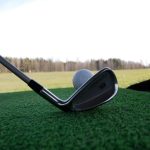Golf clubs are the essential tools that golfers wield to navigate the intricacies of the course and achieve their desired shots. With a wide range of clubs available, each designed for a specific purpose, understanding the characteristics and functions of each club is crucial for optimal performance on the golf course.
**Woods**
Woods are the longest and lowest-lofted clubs in the bag, providing maximum distance off the tee. They are typically used for long approach shots and driving the ball down the fairway. Common woods include the driver, 3-wood, and 5-wood, each with progressively shorter shafts and higher lofts.
**Irons**
Irons are versatile clubs that cover a wide range of distances and trajectories. They are typically used to hit approach shots into the green and play from the rough. Irons are numbered from 2 to 9, with lower numbers representing longer and lower-lofted clubs, while higher numbers indicate shorter and higher-lofted clubs.
**Hybrids**
Hybrids, also known as rescue clubs, are a combination of woods and irons. They provide a blend of distance and accuracy, making them ideal for shots where a wood is too long and an iron is too short. Hybrids are typically available in lofts ranging from 16 to 26 degrees.
**Wedges**
Wedges are specialized clubs designed for specific shots around the green. They have high lofts and heavy heads, allowing golfers to generate spin and control the ball's trajectory. Common wedges include the pitching wedge (45-50 degrees), gap wedge (50-55 degrees), sand wedge (56-60 degrees), and lob wedge (60-64 degrees).
**Putters**
Putters are used for rolling the ball on the green to sink it into the hole. They typically have short shafts with high lofts and are designed to provide precise control and accuracy from short distances.
**Choosing the Right Clubs**
Selecting the right golf clubs can significantly enhance your performance. Consider factors such as your swing speed, skill level, and the conditions on the course. A qualified golf professional can help you determine the best clubs for your game and ensure they are properly fitted to your physical characteristics.
**Maintenance and Care**
Proper maintenance of your golf clubs is essential to extend their lifespan and ensure optimal performance. Clean your clubs regularly with a damp cloth, and store them in a dry and protected environment to prevent damage from moisture and temperature changes. Additionally, consider having your clubs regripped and inspected by a professional on a regular basis to ensure they are in good playing condition.
**Conclusion**
Golf clubs are a vital part of the game, enabling golfers to achieve their desired shots and navigate the challenges of the course. By understanding the characteristics and functions of each type of club, you can make informed decisions about which clubs to include in your bag and how to use them effectively. Proper maintenance and care will ensure your golf clubs remain in peak condition, helping you improve your game and enhance your enjoyment of the sport.

